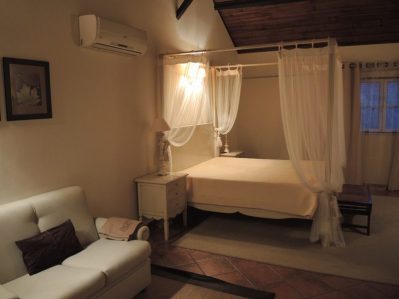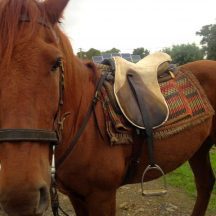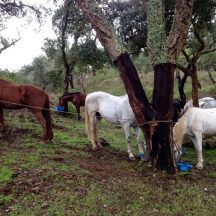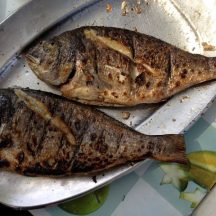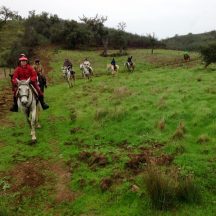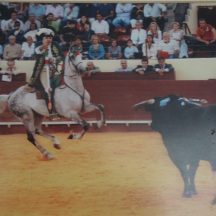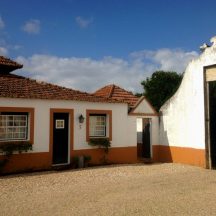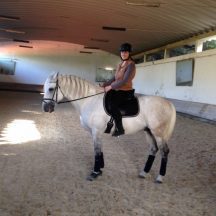Sampling Lusitano horseback riding
My week in experiencing riding vacations in Portugal was split between our host south of Lisbon and the other farther north. It began at the international airport in Lisbon as our group all found each other at the meeting point based on examining one another’s riding shoes or jackets, or perhaps recognizing the general air of a person who rides horses. It was an eclectic group, with participants from Belgium, Norway, England, Germany and Denmark. English was the common language of all and we were all happy to talk about our horses at home or other trips we had taken before. The guide, Miguel, met us and greeted those guests who were returning (some for the 8th time!) with great enthusiasm, and quickly learned all our names and gave us a useful packet with a map of our route, schedule, and contact information. The three accommodations used by the Dolphin Trail, our itinerary, form a triangle, and the riding is from one to the other, with a day of riding in each area, so that you are moving basically every two nights. The Alentejo Coast uses some of the same accommodations, and the route is linear, from either north to south or south to north depending on the date.
It took about an hour and half to drive from the airport to our first destination, which was immediately welcoming with its comfort and luxury. The accommodations throughout were wonderful in that they made guests feel at home but also pampered.
Dinner was served each night at our hotel, although later in the week a there was also a dinner at a local restaurant, and a generous breakfast buffet greeted us each morning. During our first dinner Miguel ate with us and asked us all about our riding experience and type of horse we liked, storing that information away to help with the horse designation the next morning.
Most horses are Lusitano crosses, with some pure Lusitanos as well. I had a beautiful chestnut horse aptly named “Santo,” as he was perfect for me each day that I rode him. What was lovely about riding him was that he was happy to go at a gentle lope near the end of line, and also happy to stay up front and lead the pack during our long canters. There were horses to suit all riders, including a woman who had never ridden outside of the arena before who rode a gentle older horse who knew the ropes well and followed the group faithfully. It was a fully booked group of 12 riders, and the horses behaved admirably as a whole. The saddles used were all McClellan, with comfortable layers of foam and sheepskin, and the bridles were a French style snaffle. At some points of the trip we would ride briefly along paved roads through town, and Miguel would ask us to ride in pairs along the side of the road and stay together as a group and both horses and cars behaved well!
- Santo
- Horses enjoying their lunch as we enjoy ours
- Grilled fish for lunch
- Enjoying the ride even in the rain!
After a morning of riding through cork or eucalyptus forests we would reach our picnic destination, where the backup guide had prepared a table and chairs for us, and a line to which to tie the horses. Each guest untacked her horse and then we all fed them grain in a single synchronized movement. We would enjoy salad and homemade bread with red wine until the day’s meat or fish was finished grilling and then add it to our plates. I unfortunately do not eat sea food and so missed out on the spectacular fish one day that others claimed was the best they’d ever eaten.
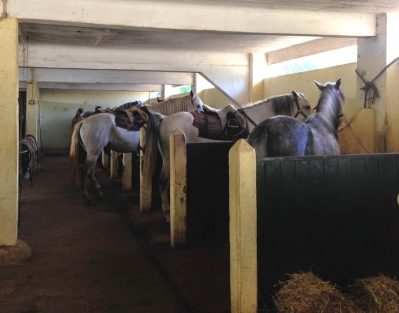
The horses at home
After a leisurely lunch we would groom and tack our horses and be off for the afternoon ride to our night’s accommodations. The horses either stayed on the grounds, or at their home stables a short distance away. Here there are rows of Lusitanos in narrow stalls, often eager for their meals while we were there, but usually spending their days in the open fields nearby.
Although it had been rainy our first few days, it did not dampen anyone’s enjoyment or enthusiasm. The weather cleared to enjoy riding under bright blue skies and for the rest of the group to continue on with the dolphin excursion and the beach. I parted ways and headed back to Lisbon and to my next destination.
Based out of Azambuja, about forty-five minutes north of Lisbon, is the stud farm that serves as the starting point for the Traditions and Culture itineraries. Although there were no trips scheduled for the time I was visiting, I got to see many of the trips’ destinations and spend some time at the farm.
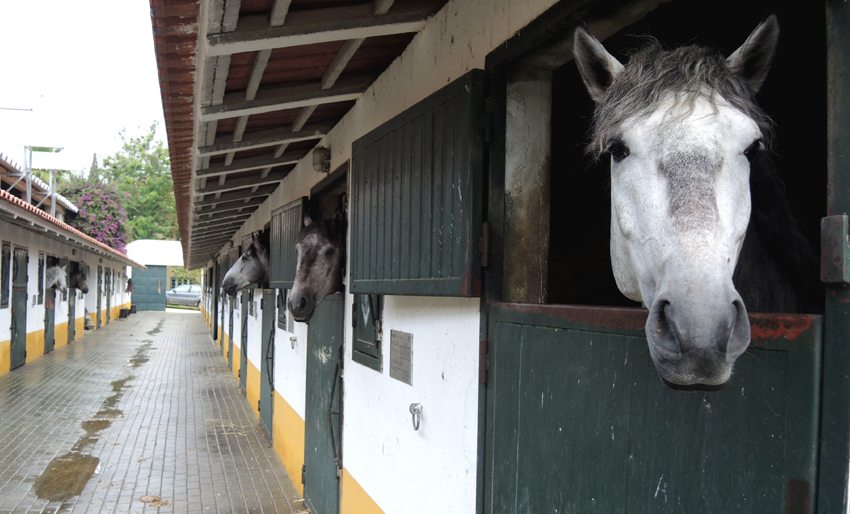
Lusitano faces
The purebred Lusitanos are bred and trained for competitive dressage and I enjoyed wandering down the stall aisles visiting the beautiful stallions and watching the trainers at their impressive work. I even got to ride one of these stallions as I sampled a dressage lesson. The horses used for the treks are all pure Lusitano mares, most bred at the farm with basic dressage skills. I rode a lovely mare called “Divulgadora” who was very easy to ride and responsive to the aids. On the trail I was especially impressed with the tack, which was all of excellent quality. I had never seen the type of saddle I rode in, in a dressage style, but with a wonderful padded seat designed for the trail which was very comfortable. Divulgadora confidently carried me through the vineyard and forest that surrounds the farm, with beautiful views of the countryside. Edgar, my guide, greeted a man in the vineyard, explaining to me that it was his cousin; Edgar had grown up there and had ridden through the land since he was young. These sorts of authentic connections to the local culture are often purposeful and unique part of these trips.
Although it was still a bit cloudy one day of touring, my host, Tiago, said that the next destination would be impressive. “I know it’s dangerous to guarantee anything 100%,” he said, “but I am that confident in this spot. You will be wow’ed.” With an introduction like that, I couldn’t wait to see where we were headed! The spot was Quinta da Boavista, one of the many quintas the itineraries travel to for lunch, dinner, or overnight. The name was perfectly suited, as the view over the Tagus River was spectacular. “Wow,” I murmured, totally proving Tiago’s assumptions correct. This was a place that would completely be enjoyed by riders on the Traditions and Culture itinerary as they stopped for lunch. The owner of this estate also is carriage driver, and at the end of the meal often drove with the riders as they left, offering a tutorial to those who were interested.
- The “wow factor” view
- A Lusitano bred by the host in a traditional Portuguese bullfight
- One of the charming quintas
This is the strength of these itineraries, the connection to the local estates and culture that it offers. Tiago has developed the itineraries keeping in mind the clear goal of eliciting the “wow” response at least once per day, be it by the beauty of the surrounding nature or the interest of a local cultural spot. Another highlight was a nearby restaurant in the town of Santarém. Called “O Forcada,” the décor is dedicated to bullfighting (a “forcado” is a group of eight men who challenge the bull directly with no weapon or defense). While Quinta da Boavista had made me feel like I was part of the nobility, O Forcada made me feel like a part of a local family. The host greeted us warmly and the restaurant’s history and authentic commitment to and love of the traditional bullfighting culture was evident. (As a note, the Portuguese style of bullfighting differs from the Spanish style in that the bull is not killed. As a former spectator of bullfighting in Madrid, I appreciate the distinction!)
The accommodations at the quintas, like at the restaurant O Forcada, all offer wonderful hospitality as the hosts seem genuinely pleased to open their homes to you. As they are authentic farm houses, the amenities are not all necessarily luxurious, but comfortable and perfectly adequate. Another special location was the Quinta da Lapa, which is an operating vineyard with lovely rooms and views. Close to the nature reserve of Torre Bela, riders on the Secrets of Ribatejo itinerary will stay here to ride through this area protected for deer, fox, boar and birds.
My week in Portugal was able to offer a wonderful introduction to the riding here, both along the coast’s southern sandy tracks and through the northern quinta farmland. The commitment of both hosts to provide a high quality experience and their fine Lusitano horses add to my confidence that this is a promising destination that will many riders will enjoy.


